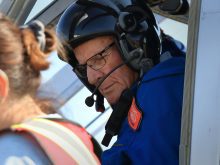A task as big as Canada is being taken on by Heather Jager of Delia, Alta.
Jager is one of 36 cyclists planning to cover 6,800 kilometres collectively on a 12-day trip from Vancouver to Halifax June 13-24.
She is one of four Alberta riders among the group of 36 national riders on the second annual Sears National Kids Cancer Ride. There are no official riders on the trip from Saskatchewan and one from Manitoba.
The ride hopes to raise $2 million for research and support programs for children with cancer.
Read Also

Support needed at all levels for high-value solar projects
Farmers, rural municipalities and governments should welcome any opportunity to get involved in large-scale solar power installations, say agrivoltaics proponents.
Jager said she was initially motivated to apply because she always wanted to bike across Canada. Then she met a 12-year-old who was celebrating 100 days of survival after cancer treatment.
“That shouldn’t be in a child’s life,” said Jager.
The two week trip, which will be done in groups of three as a leapfrogging relay, will allow all 36 to bike portions of the route across the country.
“It’s a mental game, riding. With the wind, you just have to grin and bear it.”
Jager has been training for weeks on her specialized carbon fibre bike with narrow tires. Because of the gravel roads around her rural home, she loads the bike into her vehicle and drives to Highway 9 to get her practice on pavement.
Her longest practice ride has been 100 km, but on the June trip each national rider will do about 250 km a day, burning 7,000 calories per seven-hour ride.
People can join in to cycle short portions of the ride, such as the Calgary to Strathmore, Alta., or the Moose Jaw, Sask., to Regina segment.
For more information about the ride-alongs or how to donate, visit the website www.searsnationalkidscancerride.com.
According to the Coast to Coast Against Cancer Foundation, which is assisting with the ride, cancer is the leading cause of non-accidental death in children in Canada. About 1,700 Canadian children are diagnosed with cancer each year. While more than 80 percent of them become long-term survivors and the majority are considered cured, they are still affected by their disease or treatment.
“The treatment and cure for these children is a 24-7 process, often over a period of two to three years, the effects of which can smother childhood,” said a foundation news release.














